Eric: In an interesting reversal I have decided to choose Batwoman #4 for my Comic POW! entry this week. While I haven’t hated Batwoman, it hadn’t really spoken to me that much for the first three issues. This issue, however, had everything. A powerful story, beautiful art (which the series has had since the beginning) and a shocking ending. Dan, I know you’ve been a huge fan of Batwoman – one of the few Bat-titles you actually enjoy. What’d you think of this issue?
Dan: There’s almost nothing bad to say about Batwoman. It’s an expertly executed piece of art.
Eric: As a quick reminder to our readers – what’s happened here is that some Latina villain named La Llorona is kidnapping kids. Kate Kane had a terrible experience with La Llorona and told her cousin, Plebe/Flamebird, she was out of the team. She then went to go meet her date, who thought she’d been stood up.
Dan: Detective Sawyer, right?
Eric: Right. So this issue starts off with a great artistic technique where it’s showing both what Kate and her cousin are up to at the same time. Apparently her date accepted her apology/excuse while Flamebird goes off to fight some hooligans.
Dan: It’s a pretty impressive look at two sides of the same coin (love and war)
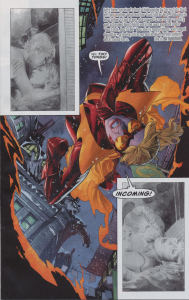
Eric: That’s a neat observation I didn’t see on my first read-through. Another thing I didn’t notice on my first read is that amazing work that the art team has done on the gutters. (We’ve mentioned gutters a few times, readers. It’s the (usually) white space between panels) All the gutters for Flamebird are, well, flames! The gutters around Kate’s love-making session almost look like the borders around a photograph – enhanced by the more realistic drawing style and choice of black and white. You almost feel like you’re seeing the photographs of a voyeur. And the more realistic style combined with your observation of love and war almost could be a commentary on love and relationships being more real than the [more] cartoony fight.
Dan: The photographic vignettes have a tender look to them compared to the brutal, visceral (literally!) beatdown that Bette takes in her misguided solo effort.
Eric: On thing I didn’t notice until I was done with my first read is that except for the first and last page, every section of this issue is a two-page spread. I realized it when I got to the end and had like 10 pages straight of ads. It’s a testament to how important the art is to this book that they complied with the artists’ request to have a series of spreads.
Dan: So that’s why the back was so packed with ads!
Eric: Yeah! So, getting back to the story, Flamebird is fighting some kids who are selling guns when La Llorona and her muscle show up. Again, on the first read, I didn’t really put two and two together, but now it seems to me that these are not coincidences and that she’s selling guns with kids. Maybe the kids she’s been kidnapping?
Dan: I think you misread that. Those kids are dead, aren’t they? I didn’t think they were kidnapped. These look like the dudes who were in that big fight last month or the month before. It’s just a gang that she’s working with or the supernatural folks are working with or something.
Eric: Oh, I see. That’s part of the problem of stories stretching on on a monthly basis – you can forget some of the details. At any rate, she tires of beating up on kids and gets excited when La Llorona’s muscle makes his presence known.
Dan: Then it all goes way south.
Eric: Yeah, I don’t think she was counting on the guy having the end of a scythe for a hand. And, poignantly, the battle ends with her left for dead as Kate (or maybe her girlfriend, I can’t tell with the art style) orgasms.
Dan: Well…poignant for some more than others.
Eric: Cut to the following morning where we’re reminded that Detective Sawyer and Kate are both working the same case. Also, the agents that have been trying to get to Batwoman find Flamebird’s body.
Dan: I was glad she was still alive until I saw that the DEO picked her up. That can only mean bad news.
Eric: After that we cut to Batwoman grilling a woman who works at the morgue and runs a supervillian clinic. We get the backstory of La Llorona, which is more or less the same as the Latino ghost story – a woman who lost her kids to a watery death.
Dan: I really liked the concept of a “mob doctor”, but for supervillains. That’s a good friend for Batwoman to have, but extremely dangerous company for that doctor to keep.
Eric: So we cut to the DEO explaining their detective work. I liked this page a lot because it gives a believable excuse for how they figure out she’s Batwoman’s sidekick. At the bottom of that page we get them extracting Batwoman’s identity from Bette as well as leaving it ambiguous whether or not she’ll survive. I’m torn on whether they kill her to give Batwoman some grief issues or keep her alive with “super hero death immunity”
Dan: Batwoman already has some pretty serious grief issues, what with her dead sister. My money’s on survival
Eric: After that we see Batwoman go grill Maria’s, aka La Llorona, father. And we learn that she’s dead – or thought to be dead. When we first started this arc, I had a problem with her potentially being dead rather than being like a Scooby Doo villain. Since then I’ve come to learn that Batman has a long tradition of having supernatural elements because of its pulp origins. And, knowing that the Batman DC Universe is a place where ghosts and spirits might be real forces actually makes this a more exciting story because it’s not guaranteed that Maria is just hijacking a Latino ghost story to keep people from investigating the kids’ deaths.
Dan: So, let me get this straight: You thought the ghost thing was a stretch in a universe that has a giant mud dude that can morph into any shape or an immortal guy who sleeps in pits?
Eric: The fiction can have whatever rules it wants, but I prefer my worlds to have a consistent set or rules, whatever those are. So even thought it’s comics, I wouldn’t expect a Bugs Bunny or Road Runner gag between Joker and Batman. I just didn’t know this was a world that had spirits and ghosts.
Dan: Fair enough.
Eric: And then we get to the end where we see that Director Bones has arrived on the scene to see the destruction of Batwoman. There have been other stories, such as Batman RIP, where the villains have known the hero’s secret identity. And there have been hints in different continuities that perhaps Joker knows (he almost certainly learned it during Batman RIP), but Joker’s insane and loves the chase, so it doesn’t require too much suspension of disbelief to not have him act on it. Having the DEO discover Batwoman’s secret so early on makes me very curious to see how this arc ends and what it means for the series going forward.
Dan: I prefer heroes like the F4 who just outright publicize their names. Secret identity stuff is boring.
Eric: I think it could go either way. Grant Morrison, in the chapter of Supergods I’m currently reading, talks about just how realistic super hero comics should be and how making them follow our common sense too much can lead to a universe that isn’t fun. For example, since the Fantastic Four have no secret identities, the Baxter building is under “constant” attack and child services actually took away (or tried to take away) Franklin. So if they do always know her identity and there are consequences I’m not saying it’s a bad or a good thing. Just that it makes me curious for how they’ll handle it since it could result in dumb stories. Sorry, that’s a bit of a strange tangent. I guess my point is that either way could be awesome or could suck and this issue leaves me, for the first time with Batwoman, very anxious for next month’s issue.
Dan: I don’t know if I’m imagining it this month, but Batwoman felt like it just flew by. I think that’s a good thing, considering how gorgeous and engaging it was. Definitely a good choice.
Eric: Yeah, it’s definitely something that happens with the action-heavy issue of an arc. And the flowing artwork almost encourages it. Well, do you think it’s time to go on to your pick?
Dan: Indeed
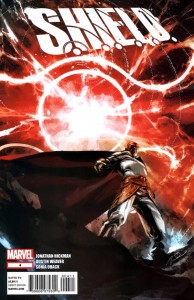
Dan’s Book
Eric: As we’ll get to in a moment, you had a VERY bold choice this week.
Dan: Gotta go big or go home sometimes.
Eric: So you selected S.H.I.E.L.D. Vol 2 #4 by Jonathan Hickman. When I saw Hickman, I knew I was dealing with a gifted writer and that jumping in anywhere other than the beginning would be a challenge. Turns out that’s an understatement! To start off, it’s not even directly related to SHIELD as we know it. There’s no Nick Fury in here (except as part of a time travel montage) Why don’t you provide the background info so people can get a taste of how crazy it is?
Dan: Well, i wouldn’t say it’s not directly related. There are references to this SHIELD in Hickman’s Secret Warriors. Not to mention the fact that Howard Stark and Nathaniel Richards are both known SHIELD agents (they are, right?). I have a feeling this will dovetail into either FF/F4 or back into Secret Warriors before it’s done, but any references to those books have been sneaky or non-surface level. In a Vol. 1 issue, Nathaniel Reed causes the time phenomenon that pulls all of the Nathaniels to the future, for example.
Eric: Good point – I just mean this is not what anyone will expect if they just know SHIELD from their appearances in X-Men or Avengers. Do you want to set up what’s going on before this issue kicks off?
Dan: The basic conflict of this book stems from an ideological difference between Leonardo Da Vinci and Isaac Newton about the role of SHIELD that is catalyzed by Leonid’s appearance in the Immortal City. Da Vinci wants to fight against the coming apocalypse and Newton believes that attempting to change the future is futile. Leonid is allowed to choose which ideology he believes in and he chooses to believe in man’s agency in his fate. SHIELD and SPEAR are meant to be the protectors of man, after all. Newton pitches a fit and runs away to the future. I’m leaving out tons of details, but that’s the general idea. Oh, also, Leonid is Newton’s son from a Deviant wife, but he was raised by Nikola Tesla (the cyborg dude). That makes sense, right?
Eric: Yeah, I remember all that from history class.
Dan: If only Renaissance history was this fun! I should lend you the trades to this. They’re very neat and mind screw-y. At the start of the book we find out a little more about the fate of SPEAR. They appeared very early on in Volume 1, but never reappeared until now. Like SHIELD, SPEAR had its problems, so they cryogenically froze their greatest three warriors to be thawed out in a time of great duress. They represent past, present, and future and I identify them as which based on how long their beards are, but I could be wrong about that characterization because their dialogue isn’t quite as clear cut.
Eric: Yup, that sounds about right.
Dan: The Da Vinci supporters get into the Voltron, I mean Megazord, I mean Human Machine to travel to 2060, the site of the prophesied end of the world and where Newton fled to.
Eric: So Da Vinci is left behind.
Dan: For reasons unexplained, but maybe it’s because he already traveled through time? Maybe it’s because he’s a quantum anchor? I’m not sure. I do think that the descriptions each of the crew members gets is neat. Leonid, who started this whole thing up, is the Source and our Caliphate represents Navigation (which will have neat effects on the rest of the book).
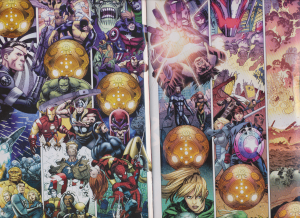
Eric: I like their travels through time because it’s a journey through Marvel time. You see the first books in The Fantastic Four and Nick Fury. Then you go to the founding of the X-Men, the Avengers, the New X-Men, Kree Skrull War, and so on. Even end up in a future with a blonde, girl Dr Doom. And finally land in the future.
Dan: First-time readers have no idea what they’re even in for when they arrive in the future. The meanings and importance of the future, the dialogue of the Caliphate, and the words Nostradamus calls Newton. This future is the future of the past. A reset button on mankind. There is nothing there. “It is the Broken Loop. The Eternal Promise.” Pure potentiality.
Eric: Yeah, I was unsure of what that really meant, but it’s about to be both trippy and awesome.
Dan: A big part of why I picked this issue was because of these next few pages. They were just so much fun to read! Gotta admit it was disorienting to then have them seemingly all appear in 2060 yet again, only it looks completely different. Technology has advanced to a tremendous state. It is truly the zenith of mankind. Most of the dialogue remains the same, save a few flavor lines from Stark/Richards and, more importantly, dialogue from the Caliphate and Nostradamus. Our favorite prognosticator calls this time, “The Feedback Loop. Tomorrow’s Tomorrow” Of the three, this is the one that I think Leonardo is seeking.
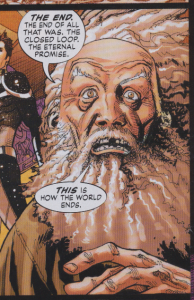
Eric: Then we redo it all again in the End of the World “The Closed Loop. The Eternal Promise”.
Dan: Pretty chilling words there, eh? To all things there is an end.
Eric: My two questions after reading this were:
1) What is the meaning of Newton’s repeated question: “Is this the future you were looking for?”
2) Are they experiencing all these futures sequentially? At the same time?
Dan: To the first I say that Newton’s question is more existential than anything. The funny thing about Newton’s flight to the future and Da Vinci’s pursuit is that there’s no indication into why there are multiple futures…Except for the Forever Man. Having not read earlier SHIELD books it may not be obvious to you that the glowy orange man is Michelangelo. Our favorite ninja turtle exists across all quantum planes. There have been issues before that highlight his simultaneous existence across potentiality. I think that he is the key to what’s going on here, but I don’t get it yet myself. I also think that the futures are occurring simultaneously
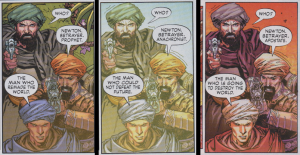
Eric: The other interesting thing is what the brothers call Netwon in each future. He’s always the betrayer, but in the Eden future he’s Prophet. In the techno-future he’s Anachronist. In the devastated future he’s Apostate.
Dan: I could speculate on all three and how his roles and attitudes make sense in each. In the techno-future mankind has (seemingly prevailed against adversity. It is a forward-looking, proactive time making Newton’s attitudes out of date. The other two futures are trickier. I mean, the world returning to its natural state as if mankind never mattered? Sure, that makes Newton prophetic. Perhaps the destroyed future is caused by Newton’s rejection of SHIELD’s stated purpose? That’s the best I can come up with.
Eric: After that we have two triptychs as our heroes fight in three different futures and the forever man preps his machine in three futures.
Dan: Not just his machine, the Human Machine.
Eric: And so now we battle in three different futures!
Dan the Prophet: POW!
Dan the Anachronist: POW!
Dan the Apostate: POW!
Battle:
Eric: Well, Batwoman is certainly the easy contender with its understandable plot as well as the fact that we’ve both been reading along the entire time. SHIELD is definitely facing an uphill battle to win. Let me start by saying that Batwoman #4 is amazingly beautiful. The story was a huge shocker to me – it’s not often the heroes lose and lose so hard. I mean, when she left the room after Kate told her not to do it, you knew something bad was going to happen, but this was on a whole other level. This is clearly going to have consequences for a while.
Dan: And yet, like all secret identity plotlines, the stakes couldn’t be lower or less interesting.
Eric: I’ll definitely have to give you that one. SHIELD also had great art, but not on as creative a level.
Dan: It’s not as aesthetically pleasing, but it’s certainly more creative in its Rashomon-like qualities
Eric: I have to say that I was prepared to deny you victory until I got to the multiple endings.
Dan: I can see how the impenetrability of the long plotline could make it tougher to read, but now you see why I keep telling you to just pick whatever and not worry about that.
Eric: When I was done reading Batwoman I was excited to read a book I’d been ready to give up on. When I was done reading SHIELD I was not only excited to see where it was going, but where it had come from. It made me want to go back and read all the previous issues. I think that makes it a very strong mid-arc (even mid-story) issue. And for that I think it deserves the win.
Dan: Wow, I’m surprised at how much you enjoyed it. It was a good battle!
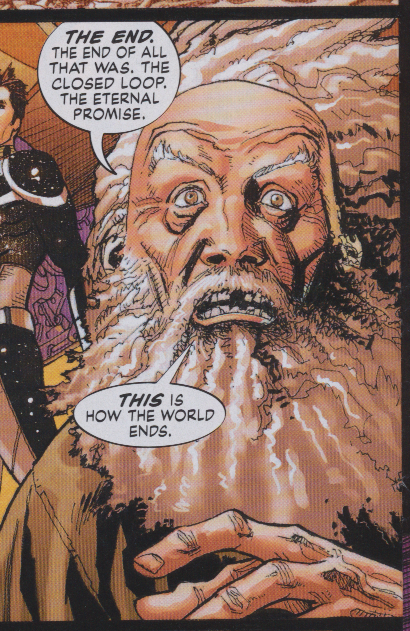
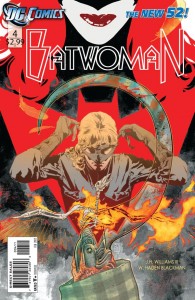
[…] fact, I might even had dropped FF without that context. Then you selected SHIELD Vol 2 #4 for the Week 7 POW and I got a sense of Hickman’s main themes. Other than father figures, he has a huge interest in […]
[…] early articles here at Comic POW! (Dan’s 2012 DC Runner Up, vs Wolverine and the X-Men, and vs SHIELD) and we’ve always praised the art and the storytelling that set it apart from the rest of the […]